5 big analyst AI moves: Apple lifted to Buy, AI chip bets reassessed
Introduction & Market Context
Ooredoo QPSC (DSM:ORDS) presented its Q1 2025 financial results on May 5, 2025, highlighting stable revenue performance while emphasizing progress on strategic initiatives aimed at diversifying beyond traditional telecommunications services. The Qatari telecom giant maintained its EBITDA margin at 43% amid varying regional performance across its operations in the Middle East, North Africa, and Asia.
Trading at QAR 12.87, Ooredoo shares have performed well over the past year, approaching their 52-week high of QAR 13.60, reflecting investor confidence in the company’s strategic direction despite flat top-line growth.
Quarterly Performance Highlights
Ooredoo reported Q1 2025 revenue of QAR 5.8 billion, essentially flat year-over-year but up 3% when excluding the impact of the Myanmar exit. EBITDA remained steady at QAR 2.5 billion, with a consistent margin of 43%. Reported net profit increased by 5% to QAR 960 million, though normalized net profit (adjusting for FX and one-time items) declined by 4% to QAR 962 million.
As shown in the following overview of Ooredoo’s Q1 2025 performance:
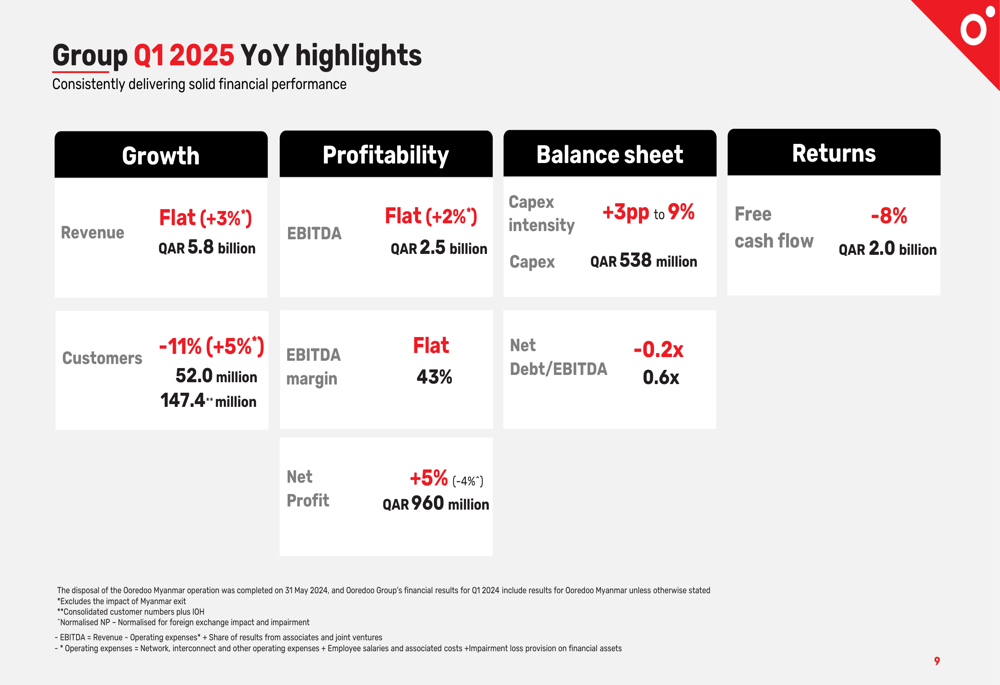
Free cash flow decreased by 8% to QAR 2.0 billion, primarily due to accelerated capital expenditure, which increased to 9% of revenue (up from 7% in Q1 2024). The company’s customer base stood at 52 million, down 11% year-over-year but up 5% when excluding the Myanmar exit.
The revenue breakdown reveals significant regional variations, with Qatar contributing 30% of total revenue, followed by Iraq (22%), Algeria (13%), Kuwait (13%), and Oman (10%). The following chart illustrates these contributions and year-over-year changes:

EBITDA contributions follow a similar pattern, with Qatar representing 37% of the group total, followed by Iraq (23%), Algeria (12%), Kuwait (10%), and Oman (10%). The company’s strongest EBITDA growth came from Kuwait (+51%) and Algeria (+12%), while Qatar and Oman experienced slight declines.
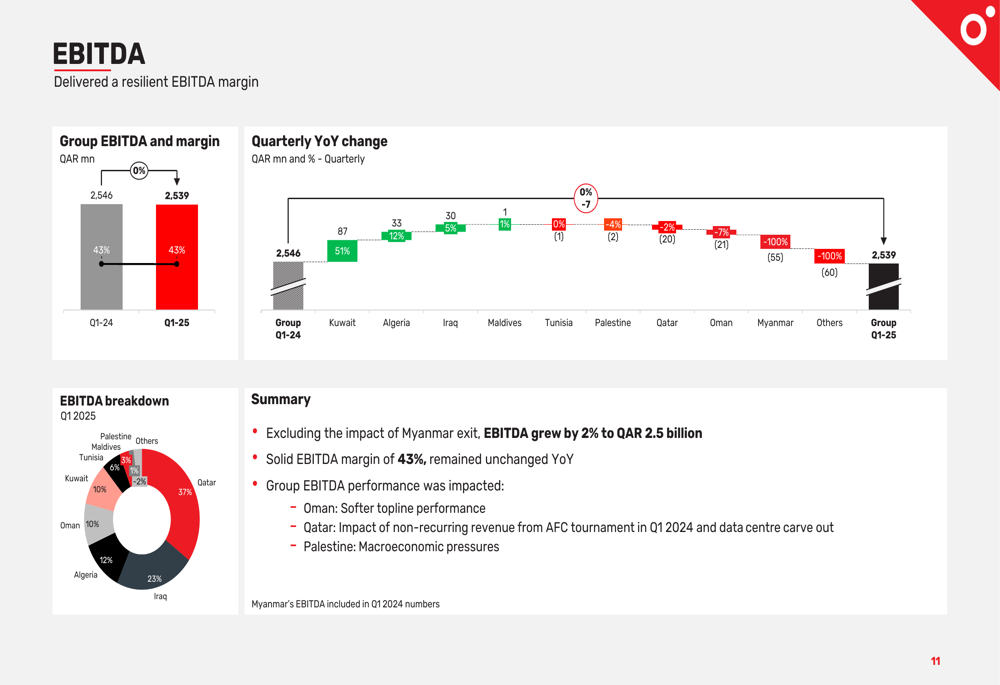
Strategic Initiatives
Ooredoo’s presentation emphasized four key strategic initiatives aimed at diversifying revenue streams and building digital infrastructure assets. These initiatives span towers, data centers, submarine cables, and fintech operations.
The company highlighted significant progress across these strategic fronts, including the creation of a regional TowerCo consolidating approximately 30,000 towers across six MENA markets, the launch of Syntys (a carrier-neutral data center company), development of an international submarine cable, and expansion of fintech operations.
As illustrated in the following strategic initiatives overview:
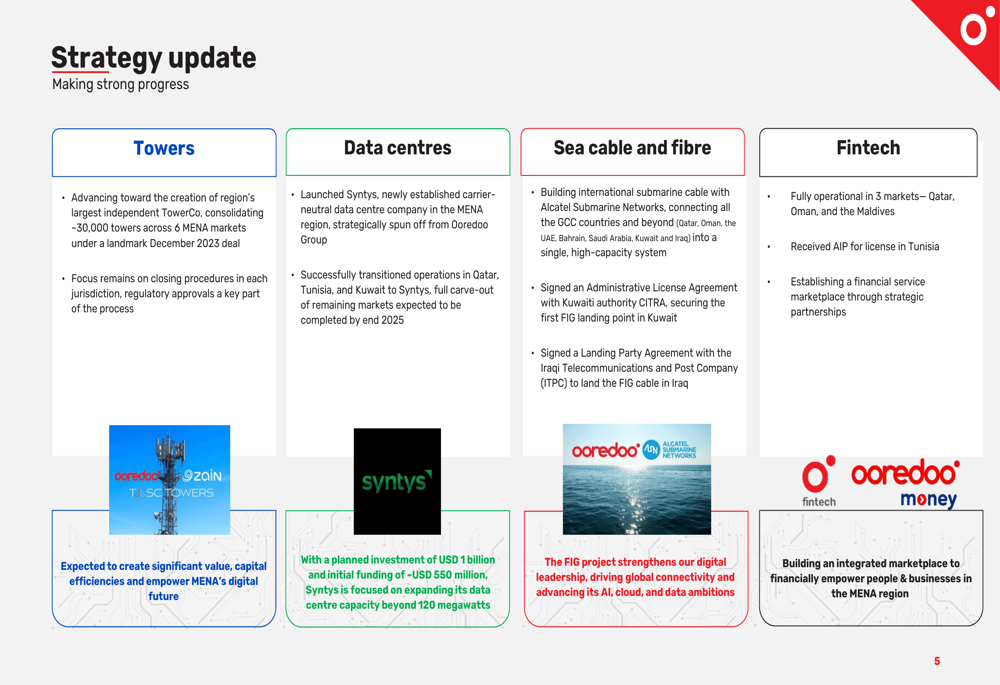
Particularly notable is the progress of Syntys, Ooredoo’s data center platform, which currently operates 13 active data centers across three countries with 19 MW of IT capacity. The company reported Q1 2025 revenue of QAR 35.2 million and EBITDA of QAR 13.4 million from this business, with 66% of revenue in Qatar coming from hyperscalers. Ooredoo has secured partnerships with Iron Mountain (NYSE:IRM) and NVIDIA (NASDAQ:NVDA), along with approximately USD 500 million in funding from major Qatari banks to support its planned USD 1 billion investment in scaling to 120 MW capacity.
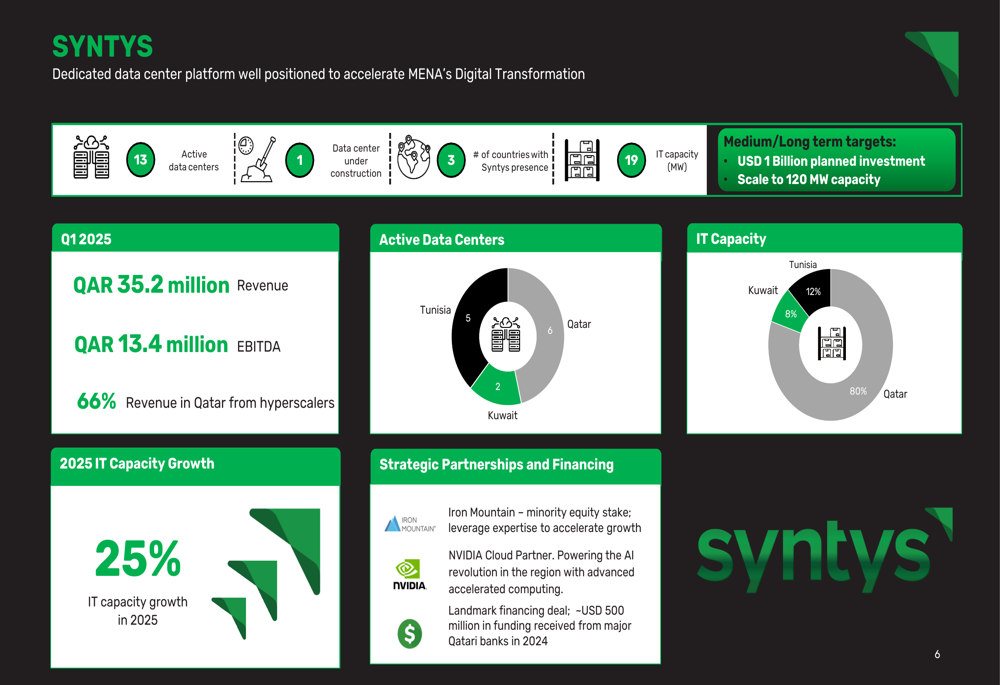
The company’s fintech initiatives are also gaining traction, with operations in Qatar, Oman, and the Maldives generating QAR 22.1 million in revenue during Q1 2025. While still in investment mode (EBITDA of QAR -1.5 million), the business has built a base of 326,000 active customers, with 81% of revenue coming from international remittances. In Qatar, Ooredoo has established market leadership, processing over USD 6 billion in transactions and capturing 20% market share in international remittances.
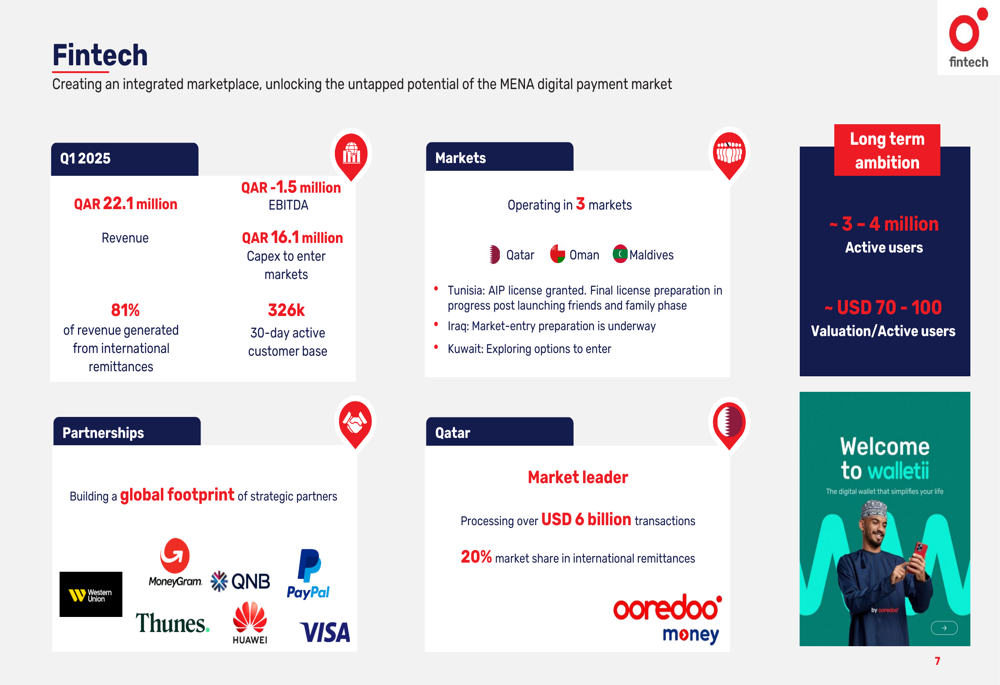
Regional Performance Analysis
Ooredoo’s operations across different markets showed varying performance:
- Qatar: Revenue decreased by 4% year-over-year to QAR 1,751 million, primarily due to lower device sales (-29% YoY). EBITDA declined by 2% to QAR 928 million, maintaining a strong margin of 53%.
- Kuwait: Revenue grew modestly by 1% to QAR 766 million, but EBITDA surged by 51% to QAR 259 million, improving the EBITDA margin by 11 percentage points to 34%. This improvement was driven by higher service revenue from voice, data, and digital services.
- Iraq: Continued its growth trajectory with revenue increasing by 5% to QAR 1,312 million and EBITDA rising by 8% to QAR 591 million. The customer base expanded by 9% to 19.7 million.
- Algeria: Delivered the strongest performance with revenue growing by 12% to QAR 743 million and EBITDA also increasing by 12% to QAR 316 million. The customer base expanded to 14.5 million.
- Oman: Faced challenges with revenue decreasing by 7% to QAR 587 million and EBITDA declining by 3% to QAR 259 million.
- Tunisia: Revenue increased by 3% to QAR 370 million with stable EBITDA. The company successfully launched 5G products in February 2025 following the issuance of licenses.
Financial Position & Outlook
Ooredoo maintained a strong financial position with a Net Debt/EBITDA ratio of 0.6x, well below the board’s guidance range of 1.5x to 2.5x. The company has a balanced debt profile with 91% fixed-rate debt and a strong liquidity position with QAR 5,459 million in undrawn committed facilities.
The following chart illustrates Ooredoo’s debt profile and financial strength:
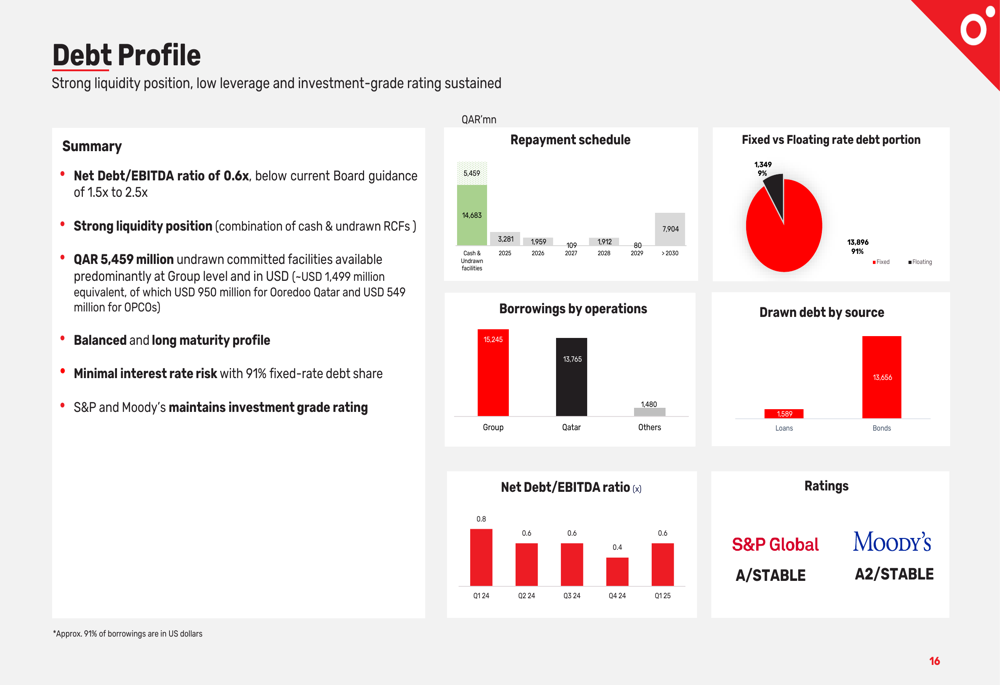
Looking ahead, Ooredoo’s Q1 2025 performance is tracking in line with its full-year guidance of 2-3% revenue growth and an EBITDA margin in the "low 40%’s." The company plans capital expenditure of QAR 4.5-5.0 billion for the full year, with Q1 spending at QAR 538 million.
As shown in the comparison of Q1 2025 actuals against full-year guidance:

Ooredoo’s strategy focuses on balancing traditional telecom services with investments in digital infrastructure and services. The company’s diversification into data centers, submarine cables, and fintech positions it to capture growth in digital services while maintaining its core telecommunications business across multiple markets.
The varying performance across regions highlights both opportunities and challenges, with strong growth in Iraq and Algeria offsetting pressures in more mature markets like Qatar and Oman. The increased capital expenditure reflects Ooredoo’s commitment to network expansion and digital infrastructure development to support long-term growth.
Full presentation:
This article was generated with the support of AI and reviewed by an editor. For more information see our T&C.
